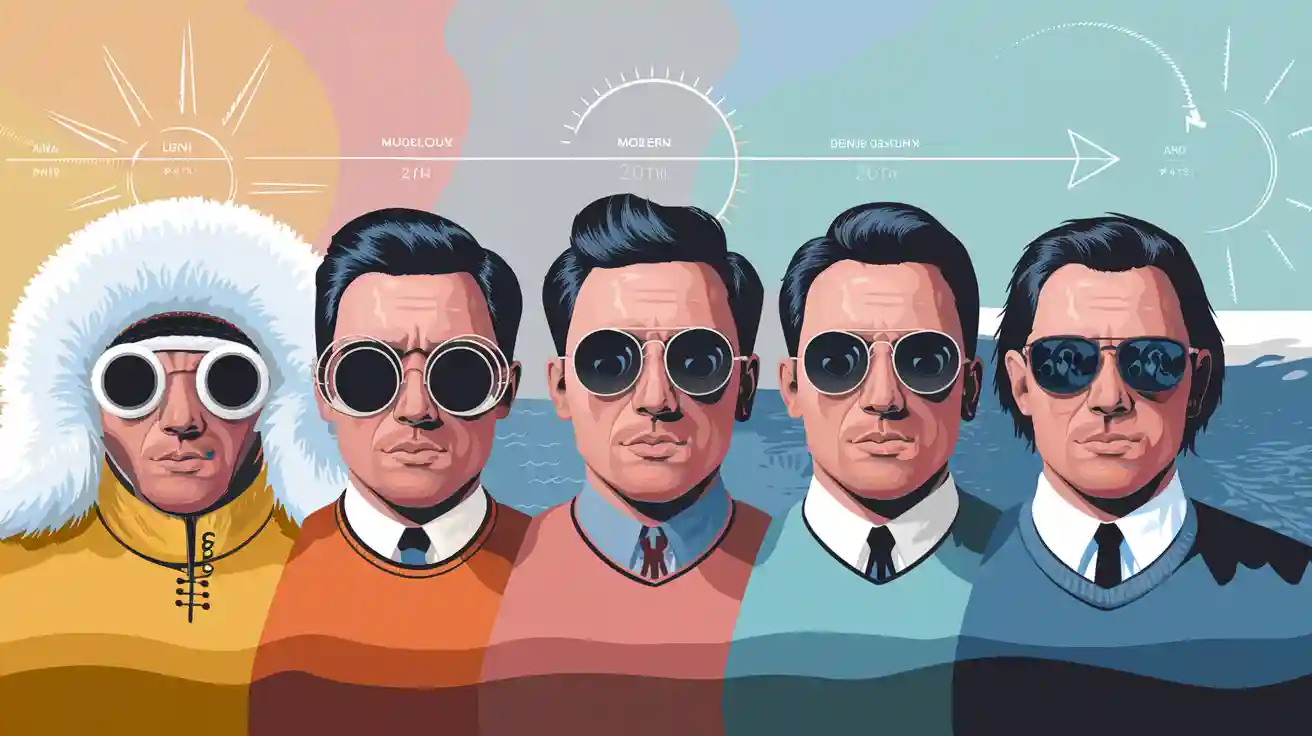
Sunglasses began as simple tools that shielded eyes from harsh sunlight and glare. Over centuries, the evolution of sunglasses turned basic eyewear into powerful symbols of fashion. Today, sunglasses serve a dual function by offering essential eye protection and expressing personal style. People choose eyewear not only for comfort but also to make a statement. The history of sunglasses reveals how the evolution of this accessory shaped daily life and culture. Sunglasses remain essential for both health and fashion.
Key Takeaways
Sunglasses started as simple tools for eye protection and evolved into important fashion accessories.
Ancient and Renaissance societies used eyewear for both practical and social reasons, showing early cultural value.
Mass production and new materials in the 20th century made sunglasses affordable, comfortable, and stylish for many people.
Technological advances improved lens safety, comfort, and performance, making sunglasses more effective at protecting eyes.
Today, sunglasses combine fashion, health benefits, and cultural meaning, with trends shaped by celebrities and social media.
History of Sunglasses
Ancient Origins
The history of sunglasses stretches back to ancient civilizations, where people first sought ways to protect their eyes from sunlight and glare. In Ancient Rome, Emperor Nero watched gladiator games through polished gems, using them as a shield against the sun’s harsh rays. Roman philosopher Seneca described using a glass globe filled with water to magnify text, showing early interest in both vision enhancement and eye protection. Roman glassblowers crafted glass spheres for magnification, which monks later used as reading stones. These early forms of eyewear were expensive and mostly available to wealthy men, since literacy was rare among women at the time.
In 12th-century China, judges wore flat panes of smoky quartz over their eyes. These early sunglasses did not correct vision but helped conceal the judges’ facial expressions during court proceedings. This practice highlights how the history of sunglasses began not only as a tool for eye protection but also as a means of social and cultural expression.
The use of sunglasses in ancient times reveals a blend of practicality and symbolism. Leaders and judges valued both the physical comfort and the authority that these early eyewear pieces provided.
The table below summarizes key milestones in the early history of sunglasses:
Time Period / Year |
Key Milestone / Development |
Quantitative Data |
|---|---|---|
Ancient Rome |
Emperor Nero used polished gems to shield eyes during gladiatorial games |
Approx. 1st century AD |
12th Century China |
Use of smoky quartz spectacles by judges to obscure expressions |
1100s AD |
Early Innovations
The history of sunglasses continued to evolve during the Renaissance. Artworks from this period often show men wearing spectacles perched on their noses or held by handles. Between 1268 and 1289, inventors in Italy created the first known sunglasses, and in 1352, Tommaso da Modena painted a monk wearing spectacles. These early sunglasses featured thick glass lenses set in frames made from leather, wood, or metal. Designers experimented with comfort and usability, using headbands or handheld handles to keep the eyewear in place.
By the 1400s, rivet spectacles appeared in Germany, and the first specialist spectacle shop opened in Strasbourg in 1466. Early prints and woodcuts from the 15th century show different spectacle designs, including those with solid bridges. These innovations marked a turning point in the history of sunglasses, as they became more widely available and began to reflect both technological progress and changing social attitudes.
Renaissance eyewear often appeared in paintings and prints, showing its growing importance in daily life.
The basic design of sunglasses remained unchanged until the 1700s, when thinner lenses and lighter frames became common.
The history of sunglasses demonstrates how people from ancient civilizations to the Renaissance valued both function and symbolism in eyewear. Over time, sunglasses transformed from rare luxury items into practical tools and cultural icons.
Sunglasses in the 20th Century
Mass Production
The 20th century marked a turning point for sunglasses. Factories began to produce sunglasses on a large scale, making them affordable for many people. Before this era, most eyewear was handmade and expensive. In the early 1900s, sunglasses became popular in America. Soldiers in World War II wore sunglasses to protect their eyes from the sun and glare. The U.S. military worked with companies to create special sunglasses for pilots. These sunglasses helped reduce glare at high altitudes and improved vision during flights.
Manufacturers used new materials to make sunglasses lighter and more comfortable. Plastic frames appeared in the middle of the century. These frames allowed for more shapes and colors, which made sunglasses more appealing to a wider audience. Lightweight metals like titanium also became popular for frames. These changes made it easier for people to wear sunglasses for long periods.
Mass production made sunglasses a common accessory. People from all walks of life could now enjoy both eye protection and style.
Technological Advances
The 20th century saw many technological advancements in sunglasses technology. Scientists and engineers developed new lens materials and coatings to improve performance and safety. The introduction of polymerized methyl methacrylate (PMMA) plastic lenses in the 1930s replaced heavier glass lenses. These plastic lenses were lighter and less likely to break. In 1946, factories began mass-producing CR-39 acrylic resin lenses, which became the standard for many years.
Anti-reflective coatings started in 1935 with Carl Zeiss. These coatings reduced glare and made vision clearer.
Scratch-resistant coatings protected plastic lenses from damage.
Multi-layer coatings combined impact resistance, anti-reflective properties, and water-repellent surfaces.
Photochromic lenses appeared, changing color based on light conditions.
The U.S. Food and Drug Administration set safety rules in 1972. These rules encouraged the use of plastic lenses over glass for safety reasons. Improvements in grinding machines made lenses more precise and affordable. These technological advancements made sunglasses safer, more comfortable, and more effective at protecting eyes.
Pop Culture Influence
Pop culture played a huge role in making sunglasses a symbol of fashion and coolness. Hollywood movies and celebrities brought sunglasses into the spotlight. When Tom Cruise wore Ray-Ban sunglasses in "Top Gun," sales of that style soared. The movie linked sunglasses with adventure and confidence. The James Bond films also influenced fashion. Designers like Tom Ford created special collections inspired by the character's style. These movies showed that sunglasses could be more than just eye protection—they could be a statement of personality.
Product placement in films helped brands reach millions of viewers. People wanted to wear the same sunglasses as their favorite stars. This trend turned sunglasses into a must-have accessory for many. The connection between pop culture and sunglasses continues today, with new styles often appearing first in movies or on celebrities.
Movies and celebrities made sunglasses a symbol of style. People saw them as a way to express themselves and keep up with the latest trends.
Modern Sunglasses Trends

Fashion Statements
Sunglasses have become powerful fashion accessories in today’s world. People use them to express their style and personality. Many choose bold frames, colored lenses, or geometric shapes to stand out. Vintage-inspired sunglasses with oversized silhouettes and bright colors are popular among young people. High-end brands like Gucci and Prada include sunglasses in their collections, making them must-have items for every season. Social media platforms such as Instagram and TikTok help set new trends. Influencers and celebrities often show off the latest designs, which quickly become popular with fans. Smart sunglasses now offer features like Bluetooth, music, and even cameras, blending technology with fashion.
The global sunglasses market reached over $23 billion in 2023 and may grow to $36 billion by 2030.
Fashion culture, luxury collaborations, and digital try-ons drive this growth.
Consumers want both affordable and premium options, with many looking for unique designs.
Eye Health
Sunglasses play a key role in protecting eyes from harmful ultraviolet (UV) rays. Health organizations like the World Health Organization and the American Academy of Ophthalmology recommend wearing sunglasses with proper UV protection. Studies show that sunglasses with full UV filtering can block almost all UV radiation, reducing the risk of eye problems such as cataracts and eyelid cancers. The effectiveness of sunglasses depends on their size, shape, and how well they fit. Large or wraparound styles offer better coverage and protection. Not all sunglasses provide the same level of safety, so checking for UV 400 certification is important.
Sunglasses Feature |
Eye Protection Benefit |
|---|---|
Large frames |
More coverage, less UV exposure |
UV 400 lenses |
Blocks 99-100% of UV rays |
Wraparound design |
Shields eyes from side glare |
Cultural Impact
Sunglasses have become symbols in modern culture. People wear them to show confidence, mystery, or a sense of coolness. In some places, sunglasses can hide emotions and make someone seem more attractive or stylish. They also play a role in group identity, such as in beach culture or among celebrities. However, studies show that sunglasses can affect how others see a person. For example, people wearing sunglasses may seem less trustworthy because their eyes are hidden. In some cultures, dark sunglasses link to certain groups or attitudes. Despite this, sunglasses remain popular as both fashion and social symbols.
Sunglasses have traveled a long path from ancient tools to modern icons. They protect eyes and show personal style. Designers continue to mix function and fashion in new ways.
A designer once faced doubts about unique sunglasses but changed opinions by working with a top lens maker.
This partnership brought together high-quality lenses and bold fashion, inspired by past decades.
Strong ties with famous brands help sunglasses blend craftsmanship, innovation, and nostalgia.
Sunglasses keep changing as new styles and technologies appear. People can see their rich history and value in daily life.
FAQ
What materials do most sunglasses use today?
Manufacturers often use plastic or lightweight metals for frames. Lenses usually come from polycarbonate or acrylic. These materials help make sunglasses strong, light, and comfortable.
How can someone check if sunglasses block UV rays?
Look for a label that says "UV 400" or "100% UV protection."
Sunglasses with this label block almost all harmful ultraviolet rays.
Why do some sunglasses have polarized lenses?
Polarized lenses reduce glare from surfaces like water or roads. They help people see more clearly in bright conditions. Many athletes and drivers choose polarized sunglasses for better vision.
Can children wear sunglasses?
Yes, children can and should wear sunglasses. Their eyes need protection from UV rays just like adults. Many brands make sunglasses in smaller sizes for kids.






